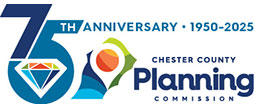Implementing Zoning Overlay Districts
Posted June 21, 2022

Chester County has a wide variety of communities which each offer a unique set of qualities, geographies, land uses, natural resources, and historic features. Because of this, a range of zoning districts exist throughout the county to address these varying communities and their specific needs.
Zoning overlay districts can be used to supplement underlying zoning to more effectively address specific land use needs and planning goals within a community. Overlay provisions can be used for targeted protection of natural resources, historic resource preservation, housing diversity, efficient transportation systems, and economic development.
Often times, the vision and goals outlined in a community's comprehensive plan or revitalization plans can serve as a good starting point for the development of zoning overlays. Depending on what is being addressed in the zoning overlay, considerations such as the compatibility of allowable uses, underlying zoning, and administration and public awareness should also be considered.
Some current examples in Chester County include East Fallowfield Township's Airport District Overlay, which regulates the height of man-made and natural objects as well as uses that negatively impact users of the Chester County G.O. Carlson Airport; Pennsbury Township's Route 1 Corridor and Brandywine Battlefield Overlay District which provides protections to historic resources and viewsheds associated with the Brandywine Battlefield National Historic Landmark; and West Chester Borough's Retail Overlay District which requires retail, restaurant and/or personal service shops to be located within a defined area of the first floor frontage in their central business district.
To learn more about zoning overlay districts, including how to implement them within a community, as well as information on the Pennsylvania Municipalities Planning Code (MPC) and additional examples in Chester County, visit our zoning overlay district eTool.
CCPC's planning eTools are intended to be user-friendly, providing a quick overview of each topic, an explanation of how it works, and considerations for addressing the topic within a community. Topic categories include agriculture; community health; economic development; environment; historic preservation; housing; land use; open space; transportation; utilities, infrastructure & energy. View the full list of eTools.

